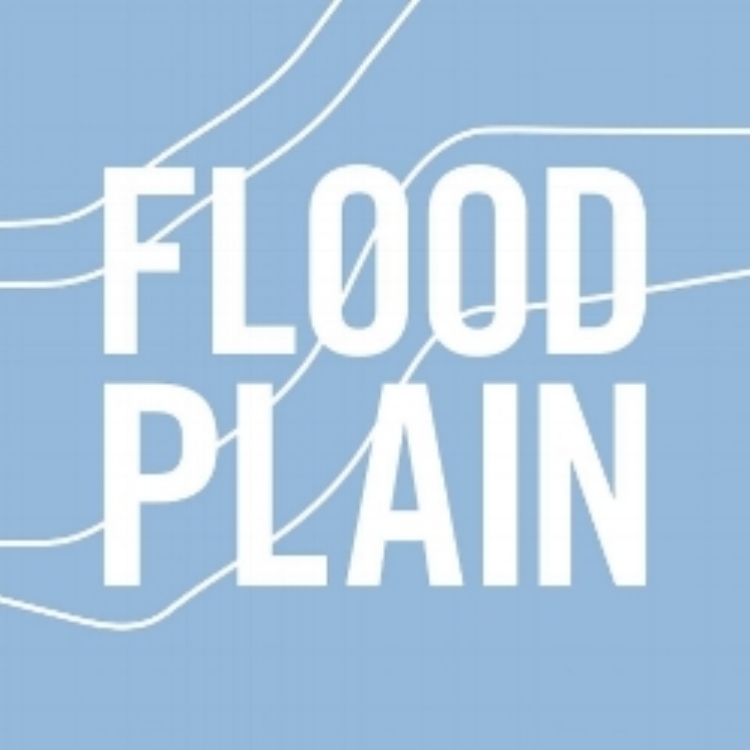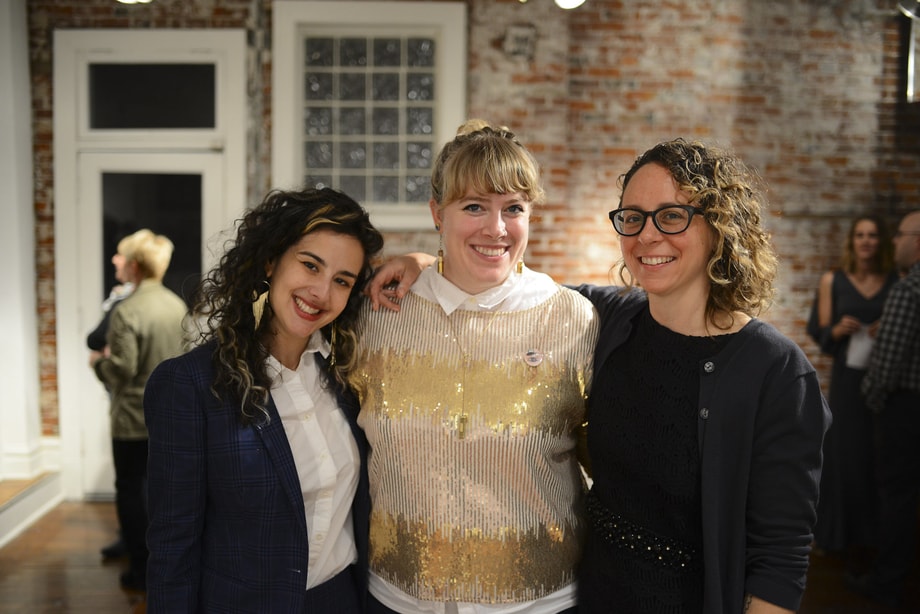Alive Magazine: Our Chat With Three Female Co-Directors Of The New Saint Louis Art Gallery, Flood Plain →
Christina Wood Posted Jan 18, 2018
In the Cherokee Street storefront that used to house beloved Saint Louis art space fort gondo, three women have launched Flood Plain, a new gallery with a vision for showcasing innovative contemporary art in the Midwest. Washington University alumnae Amelia-Colette Jones, Trina Van Ryn and Liz Wolfson came together in the spring to acquire the space, and kicked things off at the beginning of November with their first exhibition, “Time Won’t Give Me Time” by Saint Louis-based artist Brandon Anschultz.
With combined experience in visual art, arts administration and education, Jones, Van Ryn and Wolfson do have different backgrounds, but also share a vital interest in expanding the conversation about experimental art in the Midwest. They envisioned Flood Plain as a “creative laboratory” for artists exploring new ideas, and where they also hope to hold classes and events to benefit the larger St. Louis community.
Below, the three co-directors share their insights about the process of launching Flood Plain, their goals for the gallery and what they love about the artists they work with.
Photo Credit: Dave Moore
How does visual art figure into each of your respective backgrounds?
Amelia-Colette Jones: I’m originally from Texas and moved to Saint Louis in 2007 for the Visual Art MFA Program at Washington University in St. Louis. After I graduated in 2009, I fell in love with St. Louis and started the micro-funding program Sloup in 2010, which I ran until 2012. I’ve shown work as an artist in Texas and the Midwest, and in 2016 I did a fellowship with New Leaders Council. My capstone project was to create a business plan for an art space.
Trina Van Ryn: I went to Parkway West High School here in St. Louis and then went on to Washington University, where I got a BFA in sculpture and art history. Then I got my MFA from the Cranbrook Academy of Art, and since I made video art installations, I moved to Brooklyn. After a couple years, my mom, a retired Gifted Specialist, convinced me to move back to St. Louis to teach art. I’m currently the 3D art teacher at Villa Duchesne. I’ve done an artist residency at the Vermont Studio Center and [have] shown my own work in Michigan, Seattle, New York and a couple times here in St. Louis.
Liz Wolfson: I grew up in New Orleans and moved here in 2000 to do my undergraduate work at Washington University. I started doing curatorial work as an undergraduate as part of a student-run gallery group, and after graduating in 2004, I worked at several nonprofit art institutions around town, including White Flag Projects in its first couple of seasons, and the Saint Louis Art Museum. Also in 2006, I started working as a freelance art writer. I still think of myself as a writer, first and foremost. I did my MA at Saint Louis University in American Studies from 2008-2010, and am currently finishing a Ph.D. in American Studies.
What’s the story behind Flood Plain? How did the three of you connect and decide to open the space?
ACJ: I talked with Brigid Flynn and Liz Deichmann at Midwest Art Project Services about what I had started to work on during the New Leaders Council, and they put me in touch with Liz. Liz was out of town at the time, so we scheduled a phone call. I was driving to a poetry reading in North City for the call, so I pulled my car over and Liz and I talked on the phone for I think over an hour. At the end of the conversation, Liz said, “I think this is going to work.” We met in person over Liz’s spring break and the momentum has continued to build since then. It’s funny, Trina was my neighbor when I first moved to St. Louis, so I’ve known her for almost ten years. Liz and Trina also knew each other prior—so Liz and I meeting completed the triangle.
LW: When Amelia and I had our initial conversation, it immediately became clear that we shared a lot of the same programming goals and interests in experimental art practices. Trina, who I’ve known for several years and who Amelia also already knew, had expressed interest in helping with the space from the beginning. At some point it just felt natural to ask her to join as co-director. We knew she’d bring great skills and connections as an artist and professional art educator to the endeavor.
TVR: When Liz told me that she was starting a gallery in the old fort gondo space, I told her that I wanted to be involved in any capacity she saw fit. So when she and Amelia approached me to be one of the co-directors, I said ‘Yes’ even before they finished their pitch. I am thrilled to be a part of this group and to make a mark on the St. Louis art scene.
What are your goals for the gallery?
ACJ: We have two main goals. The first is to support and contribute to Saint Louis’ already vibrant creative community by providing artists with a space in which to experiment with new ideas, techniques and processes, encouraging them to expand their practices in new directions. Second, we aim to build relationships with other artists and artist-run spaces in the greater Midwest.
Our name, Flood Plain, comes from our interest in St. Louis’s position within broader regional geographies, connected by the rivers that converge nearby. By forming relationships with like-minded spaces in other cities, we hope to help facilitate opportunities for St. Louis-based artists to reach outside audiences and to expose St. Louis’ art audiences to new, interesting artists from outside the city. Through these programs we hope to highlight the many vibrant art communities that exist outside the country’s major art centers like New York and Los Angeles, which sadly often get overlooked by art collectors and national publications.
To what extent do your individual interests and aesthetic preferences overlap, and to what extent to they differ?
LW: While we all share a common interest in promoting St. Louis’ creative community, both locally and regionally, we each bring distinct perspectives to our work. We’re extremely collaborative and each share the title of co-director. Amelia is great at bringing new artists to our attention. Both she and Trina are extremely experienced with art installation, and Trina, in short, is great at building stuff. I have taken on a lot of the logistics of running a nonprofit organization. And we’re all interested in programming different community art classes and events in the space as our work progresses.
How do you collaborate on curating the space?
TVR: We all work full time and have extremely busy schedules, so basically things get done by whomever, whenever they can get to it. We try to go on studio visits as a trio, and when we installed Brandon Anschultz’s show a few weeks ago, we were all present and weighed in on issues of placement, what pieces to include or exclude, etc.
What are the challenges involved in setting up a new gallery space?
ACJ: The biggest challenge that we are currently working on is raising money to cover our overhead expenses. Though we had a very successful fundraising effort at our first opening, we are still paying almost all expenses out of our own pockets. Money is usually such a mystery in the art world, with little transparency regarding where funds come from, besides grants. We are working hard to learn about fundraising strategies and the mechanics of running a nonprofit artistic endeavor. We’re also honored and grateful to be a project of Midwest Artist Project Services, which is a wonderful resource for artists and art spaces in the Saint Louis area.
Your first exhibition is Brandon Anschultz’s “Time Won’t Give me Time.” What led you to show this artist’s work first?
LW: We were all very excited to work with Brandon, who is an established artist and whose work we all greatly admire. But just this year, he has really embarked on a completely new body of work that represents a significant shift from his practice of the past decade or more. This was really an ideal show for us from our perspective, because one of our primary goals is to encourage artists to experiment and explore new ideas, treating the gallery as a kind of creative laboratory.
All images courtesy of Flood Plain.


